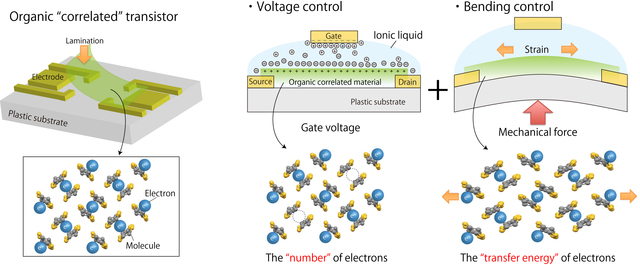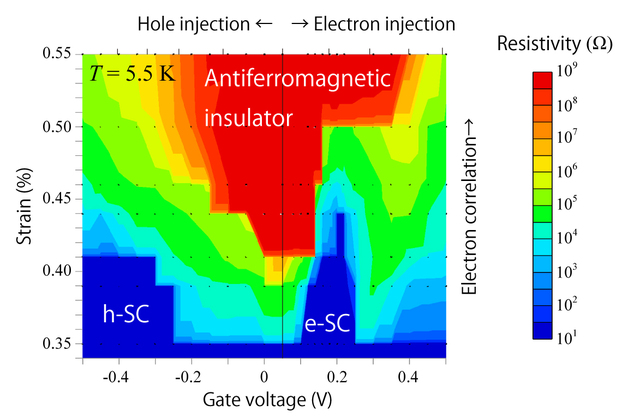Strongly correlated materials can change their resistivity from infinity to zero with minute changes in conditions. Now, researchers have fabricated a flexible organic "correlated" transistor that makes it possible to control the effective pressure and doping level by bending the substrate and changing the gate voltage, respectively. This device allows researchers to switch superconductivity on and off by using appropriate combinations of the two parameters, in a way that could lead to future quantum simulators.
In strongly correlated materials such as cuprate high-temperature superconductors, superconductivity can be controlled either by changing the number of electrons or by changing the kinetic energy, or transfer energy, of electrons in the system. Although a large number of strongly correlated materials have been examined with different parameters to understand the mechanism of superconductivity, the range of parameter control is always limited. A versatile experimental method to achieve simultaneous control of the number and the transfer energy of the electrons has been long desired.
A flexible electric-double-layer transistor (EDLT), or "correlated" transistor, composed of an organic strongly correlated material was constructed (Fig. 1) by researchers at RIKEN, Institute for Molecular Science (IMS), Nagoya University and Toho University. The number of electrons can be controlled by gate voltages of the EDLT, and the transfer energy of electrons can be controlled by bending the EDLT substrate. They found that the system changed from an insulator to a superconductor when the number of electrons was increased or decreased. The features of these superconducting states, however, were found to be fundamentally different. In addition, another superconducting state emerged when the substrate was bent. The present result was published online on Science Advances on May 10, 2019.
Figure 1. Schematic diagram of a flexible electric-double-layer transistor (EDLT), or "correlated" transistor.
Before applying perturbations by the mechanical pressure or the electric gate voltage, the organic correlated material stays in an insulating state since the electrons seat themselves snugly in their "reserved seats" at the molecules. After the gate voltage is applied, the number of electrons changes and gives rise to vacant (hole-doped) or standing (electron-doped) seats. The mechanical pressure causes the change in the distance between the seats. The appropriate combination of these perturbations switches the material to be a superconductor.
Researchers fabricated the EDLT using a crystal of the organic strongly-correlated material made of BEDT-TTF (bis(ethylenedithio)tetrathiafulvalene) molecules (Fig. 1). By applying a gate voltage on to the surface of the crystal, the number of electrons can be increased (electron doping) and decreased (hole doping). This EDLT device is flexible, and the transfer energy can be controlled by applying mechanical force (strain) from the back side of the EDLT. The researchers successfully controlled superconductivity in an identical sample, by precisely changing both the gate voltage and the strain.
Figure 2 shows the regions of superconducting states. The abscissa shows the gate voltage, which corresponds to the number of doped electrons. The ordinate shows the strain applied to the device by bending. With decreasing ordinate, the electrons move more easily because the kinetic energy of electrons increases. The region of the insulating state (red) is surrounded by regions of superconducting states (blue). Two superconducting regions to the left and the right of the insulating region are significantly different in shape on Fig. 2. In particular, the superconducting state that appeared when the number of electrons was increased (the right side on Fig. 2) shows remarkable behavior: the state appeared suddenly with just a few percent increase in the number of electrons, and disappeared with the addition of excess electrons. The superconducting states can be obtained both by increasing and by decreasing electron numbers. However, the features of the two states are found to be fundamentally different.
Figure 2. Phase diagram of the transistor. Resistivity is shown in color. The insulator region (red) is surrounded by the superconducting regions (blue). The shapes of the insulating and superconducting regions differ between the negative and positive ranges of the gate voltage. The shape of the electron-doped superconducting region (e-SC) is found to be quite anomalous.
A two-dimensional phase diagram (Fig. 2) was thus obtained using the single sample. The diagram shows the nature of the superconducting phase transition, which has been anticipated from data collected from many different samples before this device was made. Therefore this newly developed experimental method accelerates the compilation of phase diagrams. More fundamentally, drawing the full phase diagram from the same sample enables us to obtain more reliable results regardless of the effects of impurity and of difference in crystal structures.
This experimental method can apply to various organic strongly correlated materials. One interesting example is the quantum spin liquid in which the directions of electron spins are moving randomly even at zero Kelvin. Experiments on the quantum spin liquid will reveal the relationship between superconductivity and magnetism (arrangement of electron spins). Also, the phase diagram of strongly-correlated electron systems is of significant interest for building quantum simulators. The present result provides one possible standard solution for those newly-developing calculation methods.
The article
"Two-dimensional ground-state mapping of a Mott-Hubbard system in a flexible field-effect device." This article recently appeared in Science Advances and can be accessed at DOI: 10.1126/sciadv.aav7282
Authors
Yoshitaka Kawasugi, Kazuhiro Seki, Satoshi Tajima, Jiang Pu, Taishi Takenobu, Seiji Yunoki, Hiroshi M. Yamamoto, and Reizo Kato.
Keywords
Materials - Superconductors/Semiconductors; Molecular Physics; Nanotechnology/Micromachines
Contact
Hiroshi Yamamoto; TEL/FAX: +81-564-55-7334 / +81-564-55-7325. E-mail: yhiroshi_at_ims.ac.jp
Media Coverage
About Nagoya University
Nagoya University has a history of about 150 years, with its roots in a temporary medical school and hospital established in 1871, and was formally instituted as the last Imperial University of Japan in 1939. Although modest in size compared to the largest universities in Japan, Nagoya University has been pursuing excellence since its founding. Six of the 13 Japanese Nobel Prize-winners since 2000 did all or part of their Nobel Prize-winning work at Nagoya University: four in physics - Maskawa and Kobayashi in 2008, and Akasaki and Amano in 2014 - and two in Chemistry - Noyori in 2001 and Shimomura in 2008. In mathematics, Mori did his Fields Medal-winning work at Nagoya University. A number of other important discoveries have been made at Nagoya University, including the Okazaki DNA Fragments by Reiji and Tsuneko Okazaki in the 1960s; and depletion forces by Asakura and Oosawa in 1954.
In addition, Nagoya University currently engages in research and educational programs aimed at helping developing countries in Africa and Asia improve food security, nutrition and environmental conservation. For example, Nagoya University researchers have potentially solved the striga (witchweed) problem, which causes $13 billion damage annually in Africa to food crops like maize and sorghum. Field tests are now underway in Kenya. In Asia, local farmers are being trained by Nagoya University researchers in growing food crops more sustainably. And new rice varieties have been developed at Nagoya University that can feed more people and thereby reduce food scarcity in developing countries. Many other such programs are currently being undertaken by Nagoya University researchers.
About Nagoya
Nagoya is Japan's fourth-largest city with 2.2 million residents and third-largest metropolitan area after the Tokyo and Osaka urban areas. Nagoya's surrounding Aichi Prefecture has led Japan in industrial output since 1977. Greater Nagoya produces 51.7% of Japan's total automobile output and 45% of the country's auto parts. This represents 8.2% of global automobile production. The Greater Nagoya Area produces 27% of Japan's manufacturing output (versus 11% in Greater Tokyo and 10.2% in Greater Osaka) and 24% of Japan's exports. The Greater Nagoya area is the hub of Japanese manufacturing industries, producing over 40% of major manufacturing categories such as automobiles, automobile parts, machine tools and aircraft parts. Nagoya Port is Japan's largest in terms of import and export tonnage and in terms of export value. The Greater Nagoya GDP is $US461 billion: as a country it would be 22nd in the world, below Poland and above Belgium (Japanese Cabinet figures, 2015).



